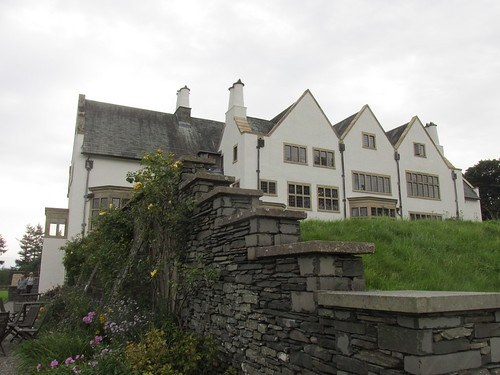It was built between 1898 and 1900 at at the time was the height of design fashion. Today it's open to the public and many of its original details are still in place.
There are lots of signs all over the place that say you can't take photos, so sorry, this is a little drab. Best thing I can suggest is that, when you've read this summary, you visit the house's website.
Baillie Scott had gained a reputation among designers by publishing sketches and ideas in The Studio magazine. It was this reputation that arned him the commission to create Blackwell. His design ideas created a spacious, comfortable, light and airy building with plenty of nooks and crannies for relaxing in.
Visitors today find the building unencumbered by any restrictions (except photography) and it's possible to sit in the many alcoves and inglenooks and contemplate the rooms in more detail than traditional don't-pass-this-rope tours that most houses offer.
The Holt family enjoyed Blackwell for several years, but began to make fewer visits after their son died during WWI. Various tenants stayed there, but when WWII broke out Blackwell took in evacuees from Huyton College in Liverpool. It became a full-time school after the war, and continued in that function until 1976.
When the school closed the house was taken over by the English Conservancy Council - later to become English Nature - and much of the decorative detail was boarded up to avoid damage from office wear and tear.
English Nature moved out in 1997 and the Lakeland Arts Trust began a campaign to buy and restore the house. Fund raising, donations and a grant from the Heritage Lottery Trust saved the house and enabled its preservation as a visitor attraction. It is now listed Grade I.
It's a delightful place to visit. Blackwell has been on my wish list for several years and didn't disappoint. The wonderful interior decoration offers something new around every cornr, up every staircase, and in every window. It's hard to choose a favourite room.
The white drawing room is exquisite, but I couldn't help thinking how soon it would look shabby in normal use. We have two black cats, and white is the least practical colour if you own pets. Not to mention the Lakeland weather. Wandering in from the garden would bring its own mud and grime and inevitably some would transfer to the furnishings.
The dining room is almost too intense to be comfortable. Think of a set for a medieval production of Morte d'Arthur: high-backed oak chairs; a magnificent inglenook fireplace made of huge chunks of local stone; ornate, painted hessian wall-covering in shades of dark green and earthy browns; wrought iron candlesticks; the complete works.
 |
| Photo borrowed from Blackwell.org.uk |


Despite the lack of photos your post has persuaded me to definitely add this house to my wish list. On our travels through the Lake District this house has been missed out, so time I think to remedy the situation. Isn't it good when you can wander around a place without too many restrictions and teezles on seats! B
ReplyDeleteBlackwell looks and sounds wonderful and I like the idea of being able to sit and take it all in without all the usual deterrents of ropes and teezles:)
ReplyDeleteSounds my cup of tea! I haven't heard of it before. Many thanks.
ReplyDeleteBlackwell is wonderful,and it looks still modern building!
ReplyDeleteHappy Friday to you!
found the idea attractive ,this building is marvelous
ReplyDeleteI'd not heard of Blackwell before today but I'm intrigued now. Shame that they don't allow photos but nice that they allow you to sit on the chairs. I hate it when they put thistles on the seats in NT properties to deter sitters!
ReplyDelete